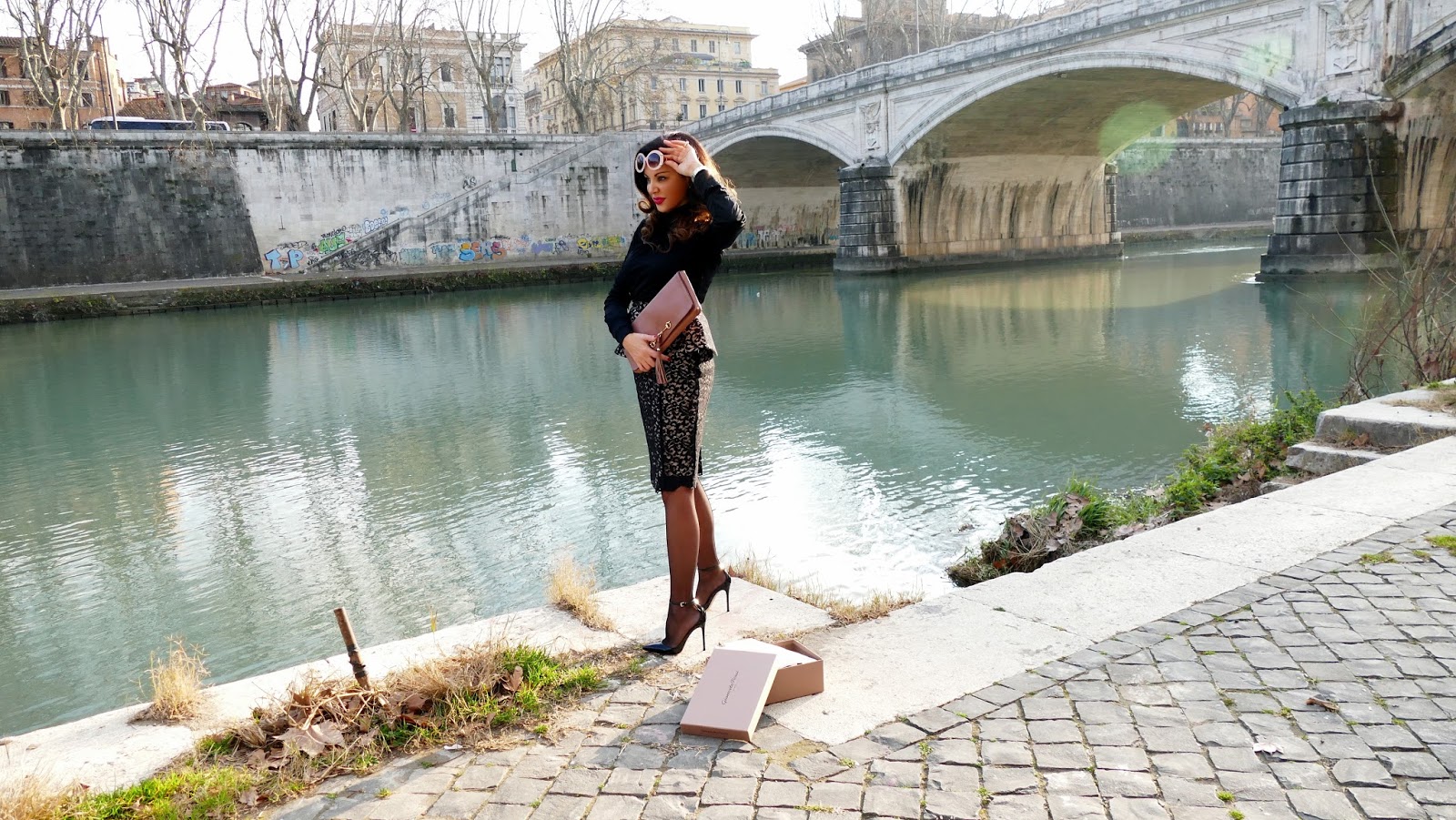
Bellissimo e maestoso monumento che rende il paesaggio del Lungotevere magico, possente custode del Vaticano il luogo più sacro della città, Castel Sant’Angelo da quasi duemila anni svetta sul Tevere, con la sua mole un tempo simbolo del potere imperiale di Roma.
Edificato intorno al 123 d.C. sull’area degli “Horti Domiziani” come un enorme sepolcro circolare per l’imperatore Publio Elio Adriano e i suoi discendenti, il Castello ha un destino atipico nel panorama storico-artistico della capitale.
Da monumento funerario ad avamposto fortificato, da oscura e terribile prigione a splendida residenza pontificia, da tribunale e carcere risorgimentale a museo e sito archeologico, Castel Sant’Angelo incarna nei solenni spazi romani, nelle possenti mura, nelle fastose sale affrescate, le vicende della Città Eterna dove passato e presente appaiono indissolubilmente legati.
Sembra che in questo luogo vi si aggirino molti fantasmi, oltre a quelli dei numerosi condannati a morte, i cui lamenti si levano ancora dalle antiche pietre del Castello, il più famoso è quello di Beatrice Cenci. Giovane e bella nobildonna romana, condannata a morte per l’uccisione del padre, uomo violento che la sottoponeva a costanti abusi.
Fu decapitata la mattina dell’11 settembre 1599 nella piazza di Castel Sant’Angelo gremita di folla e su ponte Sant’Angelo si dice che il suo fantasma compaia ancora, ogni anno, puntualmente, nella notte tra il 10 e l’11 settembre.
La nota leggenda che lega, invece, il nome del Castello a quello dell’arcangelo Michele risale al X secolo, quando Gregorio Magno sale al soglio pontificio di una città in preda all’anarchia, alla carestia e a una terribile pestilenza.
Per invocare la misericordia divina, papa Gregorio organizza una processione di tre giorni a cui prende parte l’intera cittadinanza e giunti all’altezza del mausoleo di Adriano, però, i romani distinguono chiaramente stagliarsi contro il cielo violetto la sagoma luminosa di un angelo nell’atto di riporre nel fodero una spada fiammeggiante. E’ il 29 agosto del 590.
Quella sera stessa la pestilenza cessa. Il mausoleo di Adriano è diventato il Castello dell’Angelo.
Sorge sulla sponda destra del fiume, lo si raggiunge dal ponte Sant’Angelo, decorato da dieci angeli scolpiti dal Bernini nel XVII secolo, su volere di Papa Clemente IX.
Fu decapitata la mattina dell’11 settembre 1599 nella piazza di Castel Sant’Angelo gremita di folla e su ponte Sant’Angelo si dice che il suo fantasma compaia ancora, ogni anno, puntualmente, nella notte tra il 10 e l’11 settembre.
La nota leggenda che lega, invece, il nome del Castello a quello dell’arcangelo Michele risale al X secolo, quando Gregorio Magno sale al soglio pontificio di una città in preda all’anarchia, alla carestia e a una terribile pestilenza.
Per invocare la misericordia divina, papa Gregorio organizza una processione di tre giorni a cui prende parte l’intera cittadinanza e giunti all’altezza del mausoleo di Adriano, però, i romani distinguono chiaramente stagliarsi contro il cielo violetto la sagoma luminosa di un angelo nell’atto di riporre nel fodero una spada fiammeggiante. E’ il 29 agosto del 590.
Quella sera stessa la pestilenza cessa. Il mausoleo di Adriano è diventato il Castello dell’Angelo.
Sorge sulla sponda destra del fiume, lo si raggiunge dal ponte Sant’Angelo, decorato da dieci angeli scolpiti dal Bernini nel XVII secolo, su volere di Papa Clemente IX.
Il ponte è unico al mondo, sia per la regolarità, la simmetria, l’apertura della luce e la distanza dal pelo dell’acqua degli archi, sia per la nobiltà dei materiali e la monumentalità dell’insieme.
La nota maggiore di tanta bellezza è aggiunta dalle statue degli angeli che fiancheggiano i parapetti marmorei del ponte, i quali, come cornici, inquadrano il fiume che scorre attraverso l’intreccio di grate in ferro battuto di particolare eleganza.
Elegante anche la mia mise, una pencil skirt in pizzo e un paio di lucide decollète… e il libro di Dan Brown “Angeli e Demoni” balena nella mia mente mentre attraverso tutto il ponte Sant’Angelo.
(Clicca qui e qui se vuoi vedere i miei precedenti post da Roma).
(Clicca qui e qui per vedere tutte le gonne più cool di stagione).
A b
A beautiful and majestic monument that makes magical the Tiber landscape, the mighty guardian of the Vatican the holiest place of the city, Castel Sant’Angelo since almost two thousand years stands on the river, with its impressive mass as a symbol of imperial power of Rome.
Built around 123 A.D. as a tomb for Emperor Hadrian and his family, the castle has an unusual destiny in the historical and artistic scene of the Italian capital.
From funerary monument to a fortress, from dark and terrible prison to a splendid papal residence, from the court of the Risorgimento to a museum and archaeological site, Castel Sant’Angelo embodies in the solemn Roman spaces, in the mighty walls, in the sumptuous frescoed halls, the events of Eternal city where past and present seem inextricably linked.
It seems that in this place there are many ghosts that wander about, in addition to those of the many death row inmates, whose cries will still rise from the ancient stones of the Castle, the most famous being that of Beatrice Cenci. A beautiful Roman noblewoman, who was sentenced to death for the murder of her father, a violent man who underwent her at constant abuse. She was beheaded on the morning of 11 September 1599 in the square in Castel Sant’Angelo crowded with people and on the Ponte Sant’Angelo, and her ghost still appears, every year, on the night between 10 and 11 September.
Gregory the Great’s vision of St Michael is one of the best known and most charming legends of the first plague pandemic. Gregory was elected Pope after the death of his predecessor from the plague in the 590s. In an effort to plead with God for an end of the plague, the new Pope Gregory led a procession, around the streets of Rome. As they approached Hadrian’s Tomb, Gregory had a vision of Michael the Archangel atop the tomb overlooking the city, sheathing his sword, a sign that Gregory’s procession had been pleasing to God and that the plague would end.
Located on the right bank of the Tiber River and reachable from the Sant’Angelo bridge, decorated with ten angels sculpted by Bernini in the seventeenth century on the wishes of Pope Clement IX.
The bridge is unique in the world, both for regularity, the symmetry, the opening of the light and the distance from the water surface of the arches, both for the nobility of the materials and the monumentality of the whole structure.
Most of such beauty is added by the angel statues that flank the marble railings of the bridge, which frame the river that flows through the interweaving of wrought iron grilles of particular elegance.
The same elegance of my outfit, a lace pencil skirt with patent leather heels… and, Dan Brown’s book, “Angels and Demons” flashed through my mind as I crossed the Ponte Sant’Angelo this morning in Rome.
Built around 123 A.D. as a tomb for Emperor Hadrian and his family, the castle has an unusual destiny in the historical and artistic scene of the Italian capital.
From funerary monument to a fortress, from dark and terrible prison to a splendid papal residence, from the court of the Risorgimento to a museum and archaeological site, Castel Sant’Angelo embodies in the solemn Roman spaces, in the mighty walls, in the sumptuous frescoed halls, the events of Eternal city where past and present seem inextricably linked.
It seems that in this place there are many ghosts that wander about, in addition to those of the many death row inmates, whose cries will still rise from the ancient stones of the Castle, the most famous being that of Beatrice Cenci. A beautiful Roman noblewoman, who was sentenced to death for the murder of her father, a violent man who underwent her at constant abuse. She was beheaded on the morning of 11 September 1599 in the square in Castel Sant’Angelo crowded with people and on the Ponte Sant’Angelo, and her ghost still appears, every year, on the night between 10 and 11 September.
Gregory the Great’s vision of St Michael is one of the best known and most charming legends of the first plague pandemic. Gregory was elected Pope after the death of his predecessor from the plague in the 590s. In an effort to plead with God for an end of the plague, the new Pope Gregory led a procession, around the streets of Rome. As they approached Hadrian’s Tomb, Gregory had a vision of Michael the Archangel atop the tomb overlooking the city, sheathing his sword, a sign that Gregory’s procession had been pleasing to God and that the plague would end.
Located on the right bank of the Tiber River and reachable from the Sant’Angelo bridge, decorated with ten angels sculpted by Bernini in the seventeenth century on the wishes of Pope Clement IX.
The bridge is unique in the world, both for regularity, the symmetry, the opening of the light and the distance from the water surface of the arches, both for the nobility of the materials and the monumentality of the whole structure.
Most of such beauty is added by the angel statues that flank the marble railings of the bridge, which frame the river that flows through the interweaving of wrought iron grilles of particular elegance.
The same elegance of my outfit, a lace pencil skirt with patent leather heels… and, Dan Brown’s book, “Angels and Demons” flashed through my mind as I crossed the Ponte Sant’Angelo this morning in Rome.
(Click here to see all the coolest pencil skirts of this winter).
Location: Castel Sant’Angelo – Tiber River – Rome – Italy
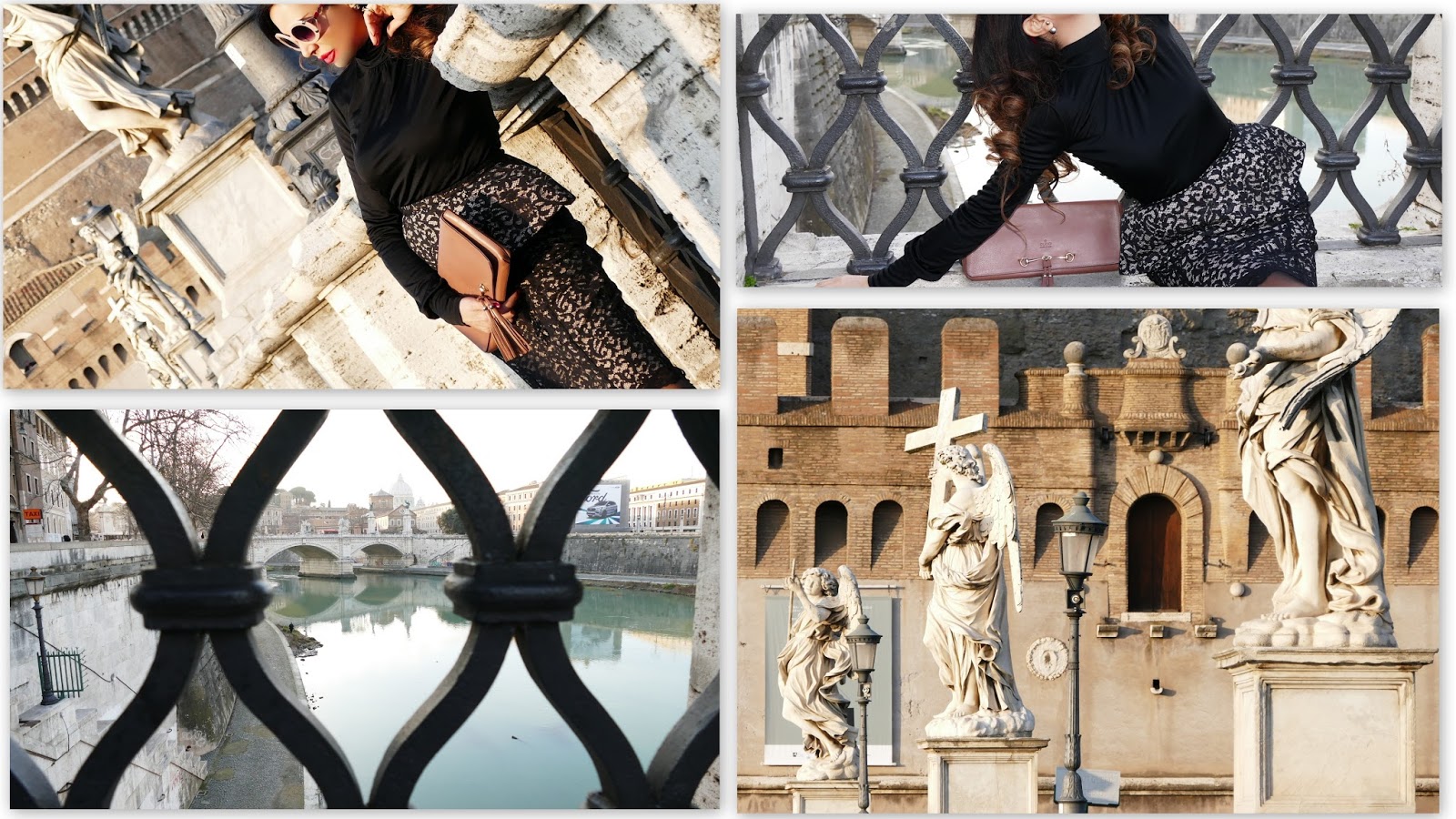
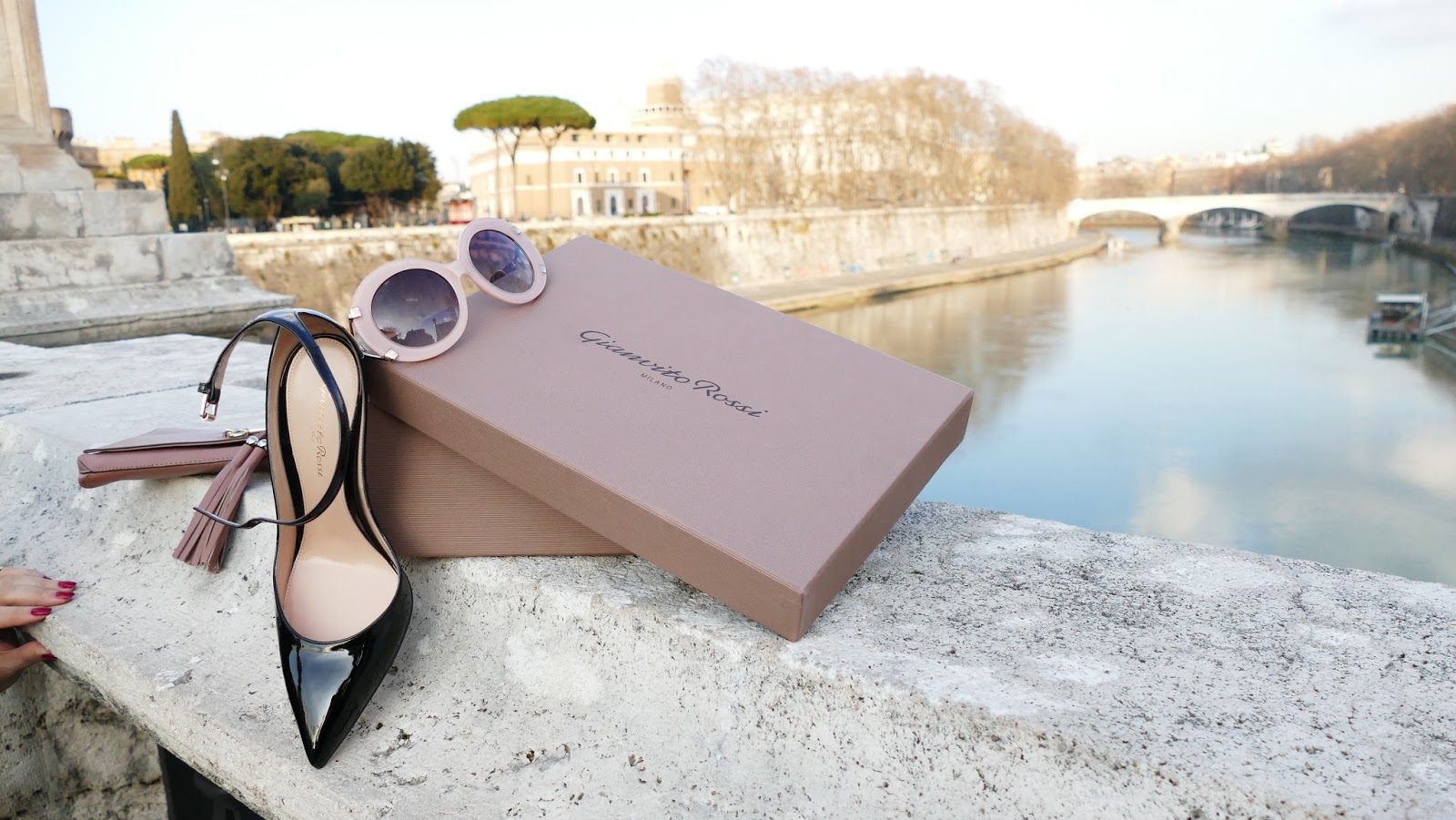
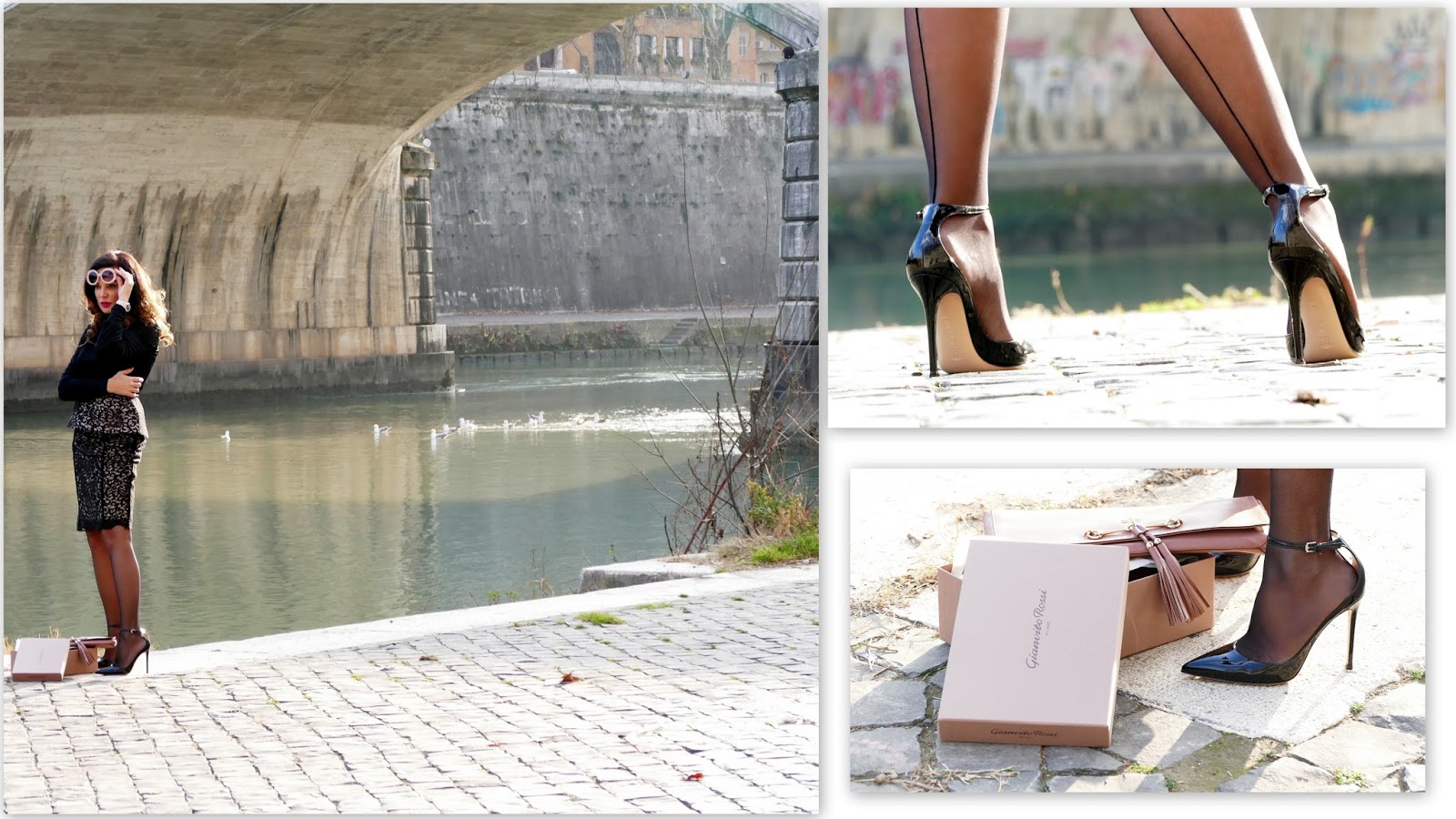
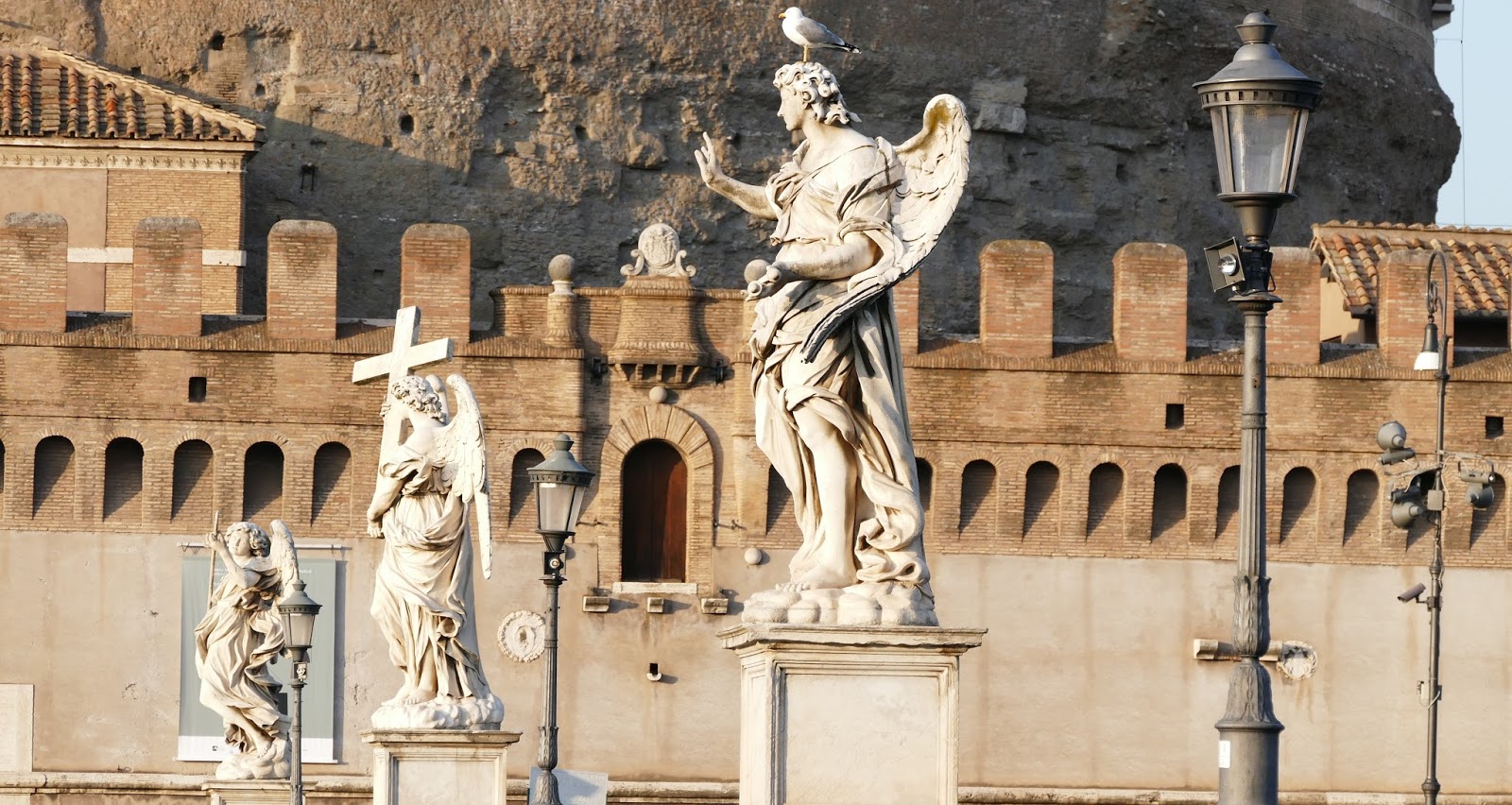
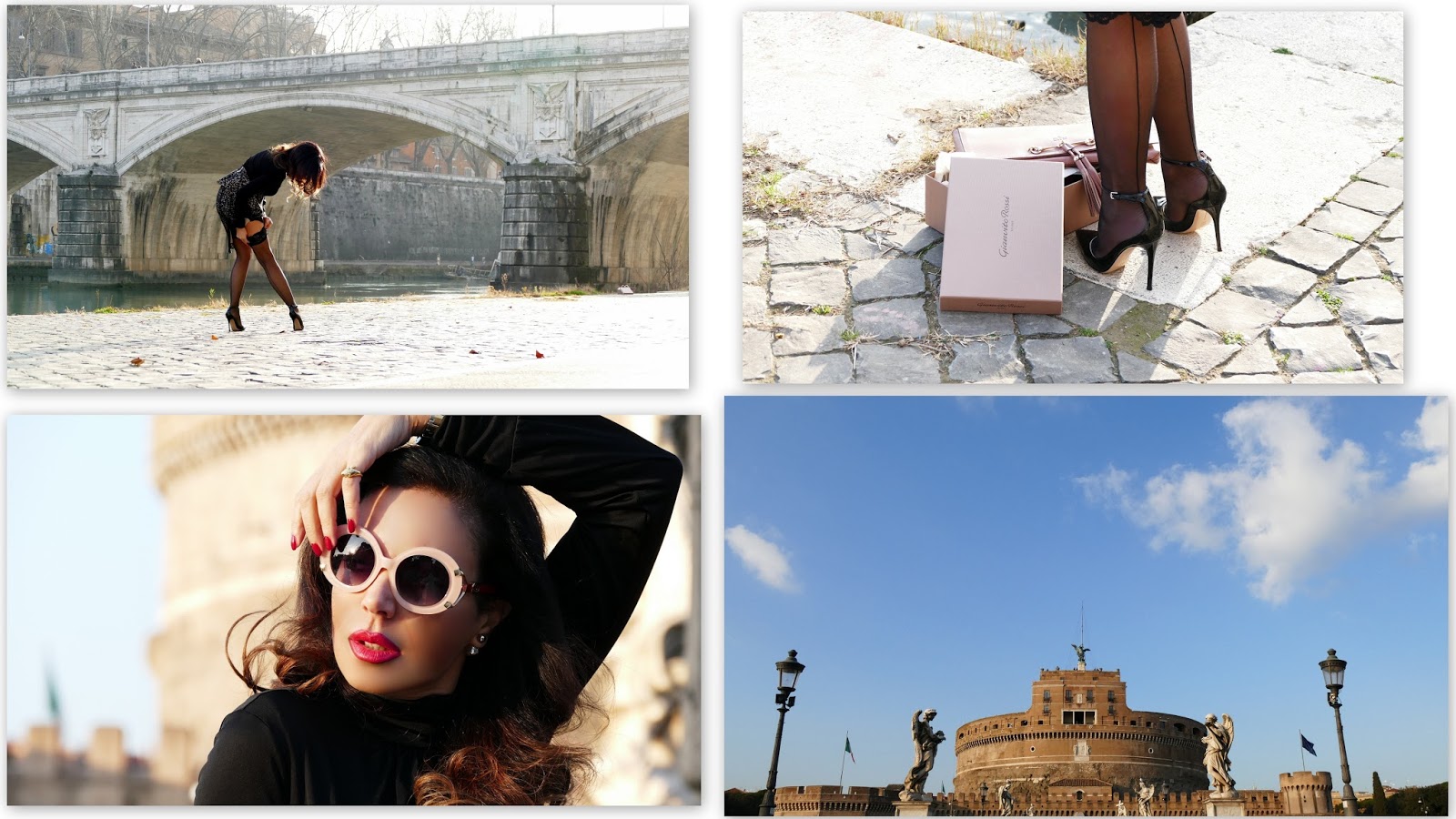

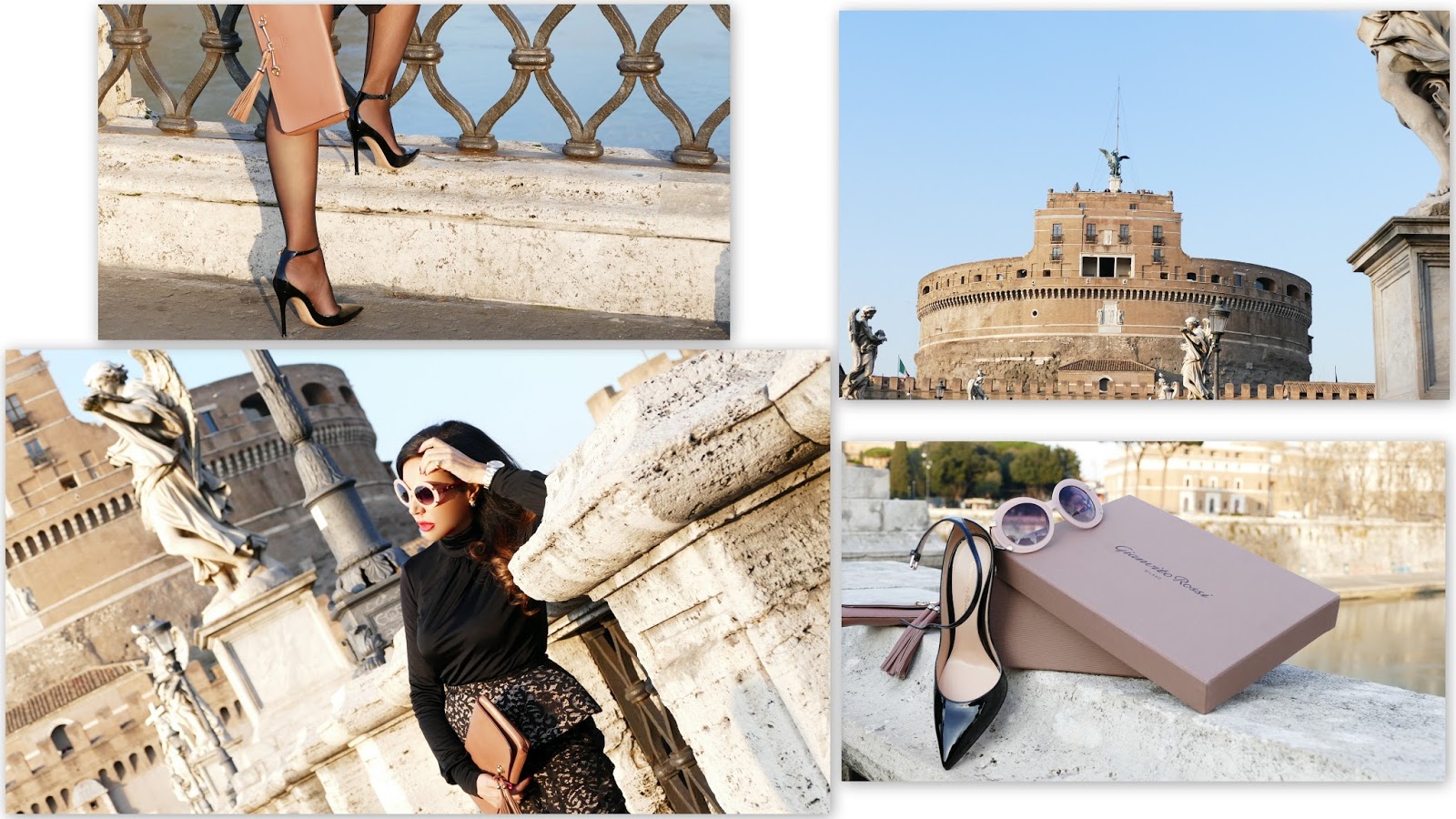
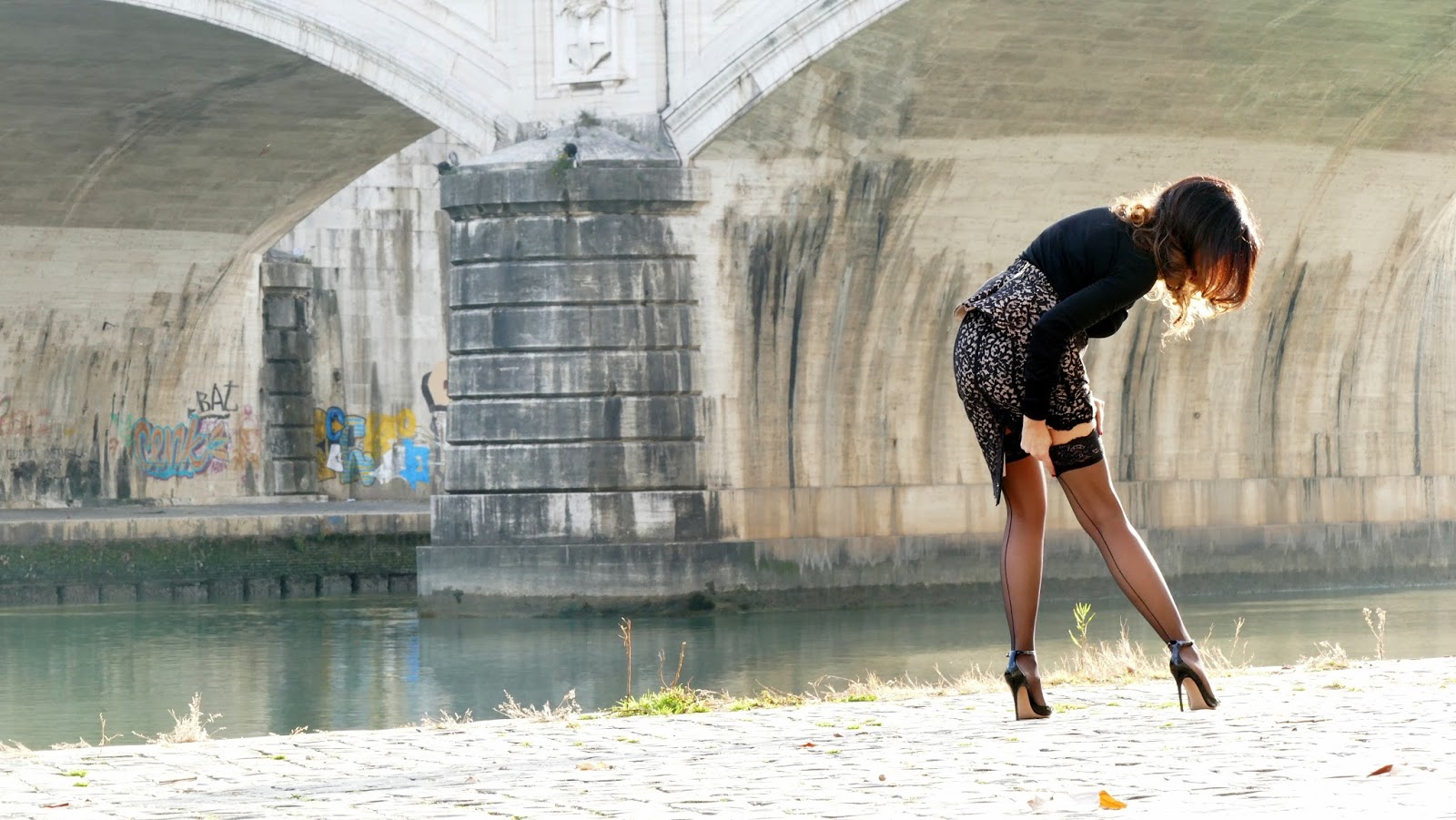
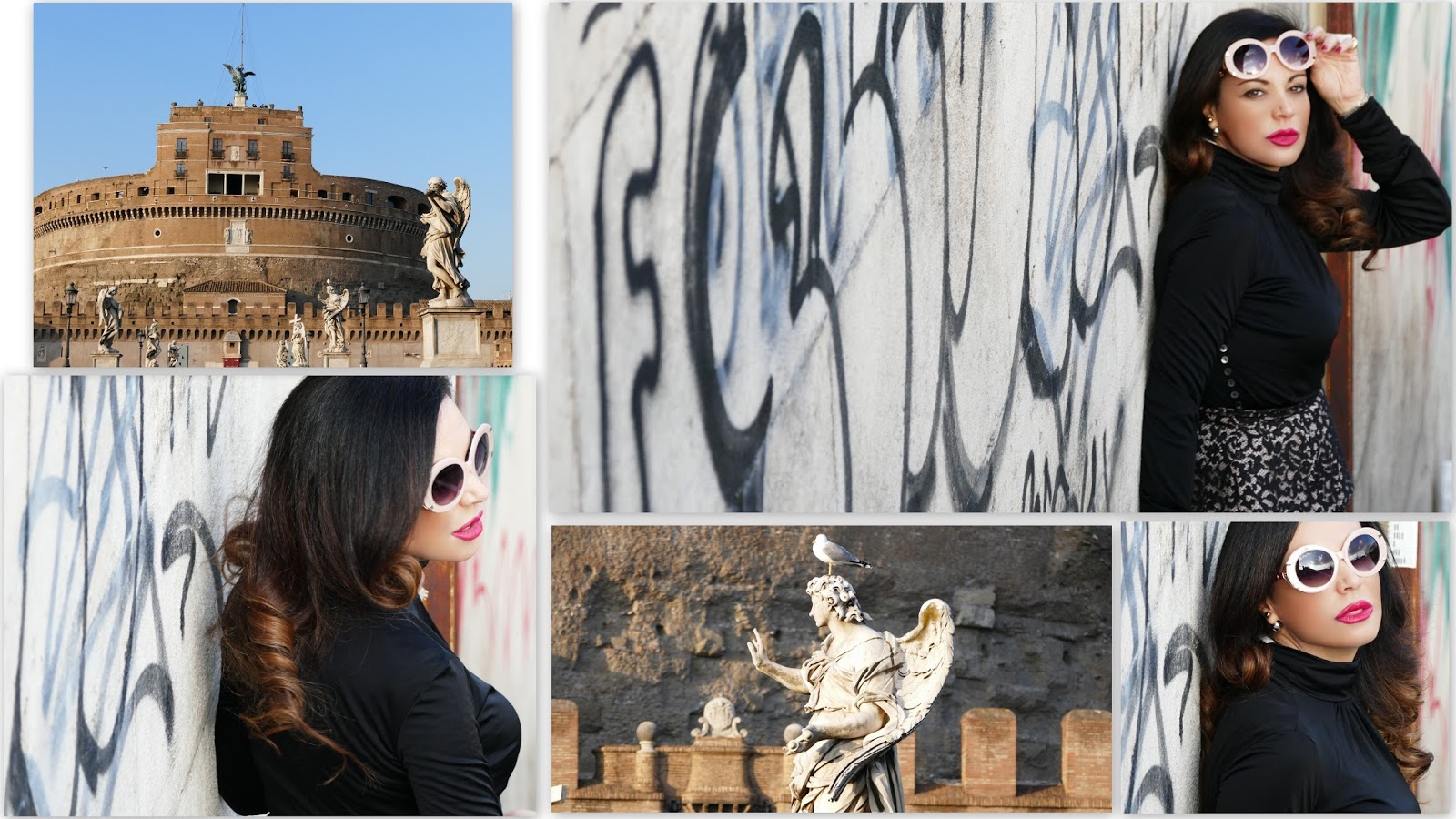
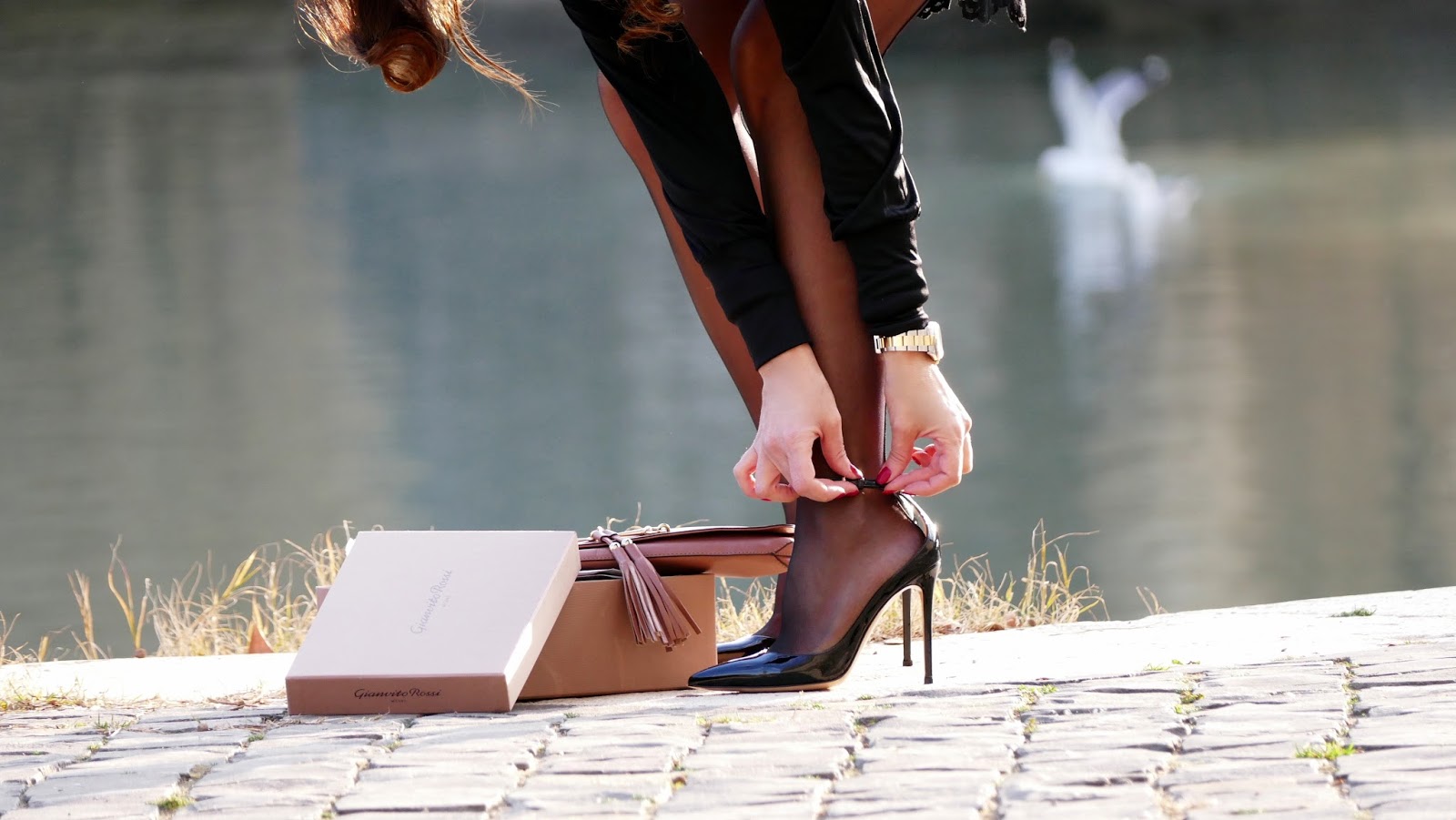
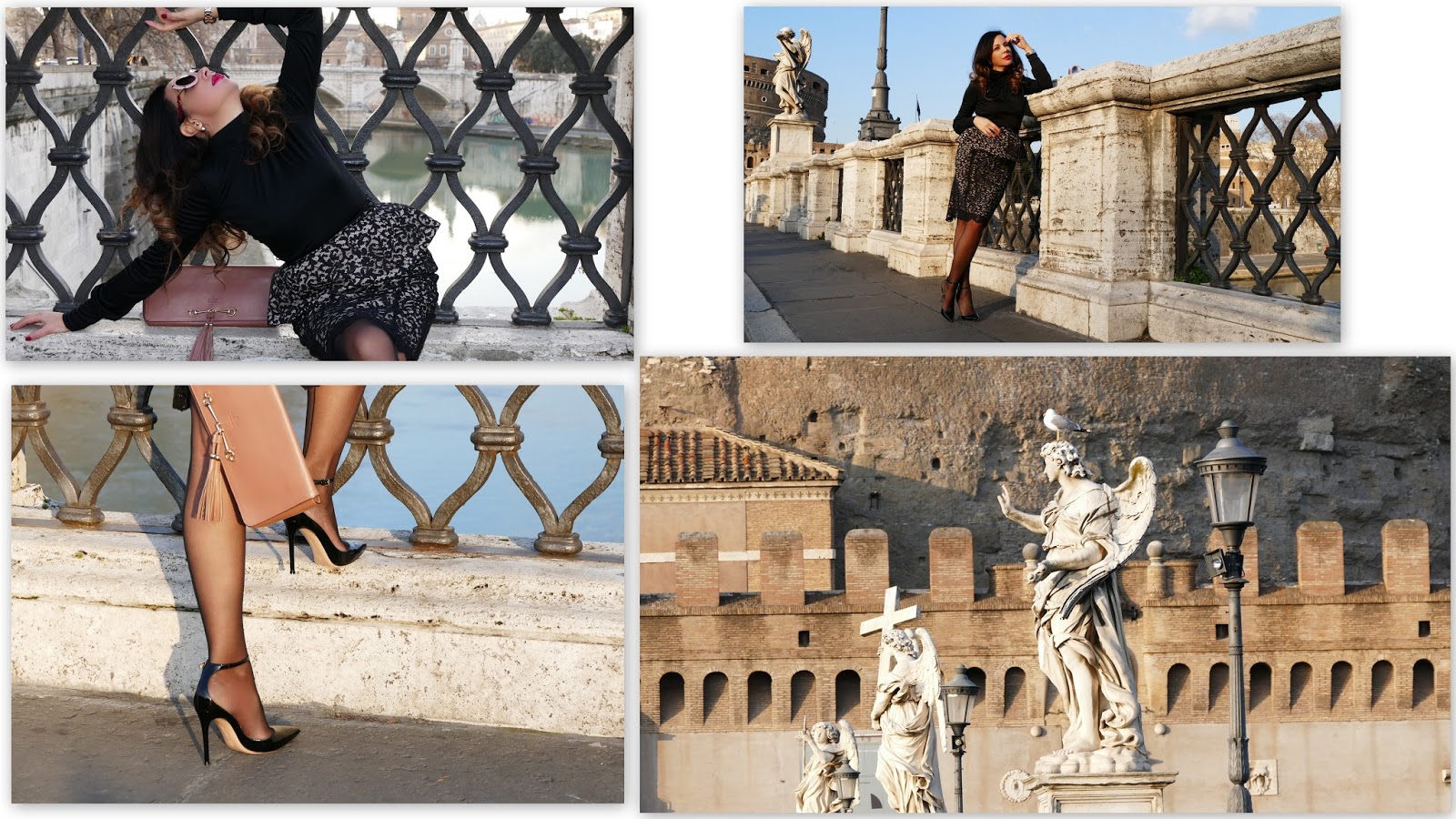
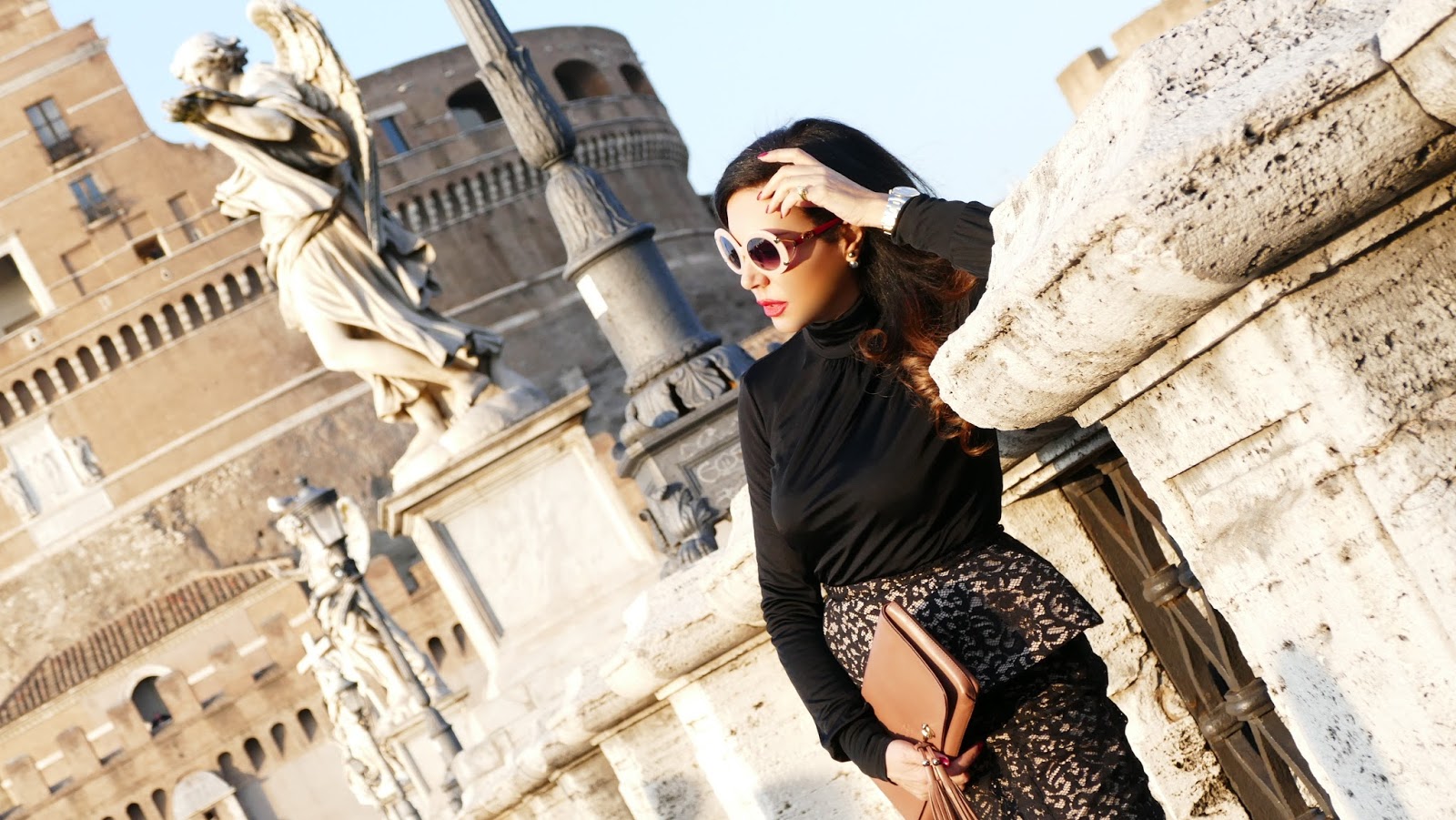
Photos: GerardoFusco.it
I was wearing:
Dolce & Gabbana turtleneck
Mangano peplum skirt
Gucci sunnies and clutch
Gianvito Rossi heels



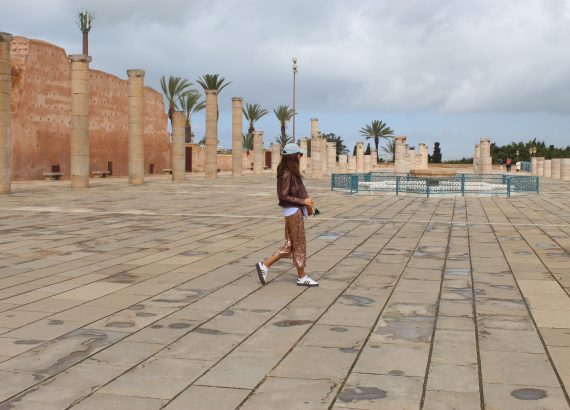
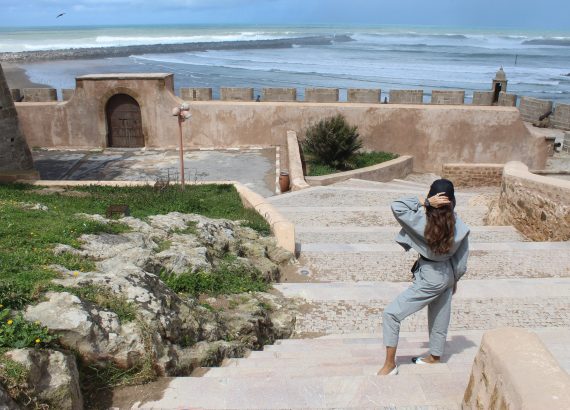
Always fierce! I love your pictures!
THE PINK ELEPHANT SHOE // INSTAGRAM //
You look so amazing Paola. Your shoes are so chic.
Simera |Beautetude
Those shoes are too fabulous and you look super glam Paola!
Splendid and glamorous!
Gemma
The Style Collector
Wow….sei l'eleganza e la femminilità allo stato puro.
Quelle scarpe….un sogno! Kiss
Nuovo post “DEZUU t-shirt personalizzate” ora su http://www.littlefairyfashion.com
Your heels are super cute.. The heel height alone is giving me serious life..
Happy monday darling.
Glowyshoes's blog
Oooooooooooooo, you look saucy in that outfit!!! – http://www.domesticgeekgirl.com
Wow. That site is spectacular and so is your outfit. Love the touches of blush.
Sxx
http://www.daringcoco.com
Che spettacolo……sempre super elegante!!!!
Baci bellezza!!!
Marta
http://www.lagattarosablog.it
Amazing look dear! ♥
kiss
New post on my blog: http://vesnamar.blogspot.rs/2017/02/winter-uniform.html
Sempre meravigliosa!
LA BORSA DI MARTINA
Queste foto in giro per roma sono strepitose e tu sfoggi un look più bello dell'altro! Questo è di un femminile pazzesco!!!
Un bacione! 💕 F.
La Civetta Stilosa
Bella la calza con la riga. L'occhiale nel colore tenue e delicato, l'abito… tutto nel tuo post parla di una Roma sensuale, femminile e del buon gusto italiano!E soprattutto è uno stile che tutte noi possiamo replicare e adottare con le varianti personali, ricordando che ogniuna di noi è bella così come è!
Scusate la " i " in ognuna è dovuta ad un errore di battitura veloce, perdonatemi!!
Chic, femminile strepitosa, hai superato la bellezza di Roma! baci
Look maravilhoso show de imagens, tenha uma semana
abençoada, obrigado pela visita.
Blog: https://arrasandonobatomvermelho.blogspot.com.br/
Canal:https://www.youtube.com/watch?v=DmO8csZDARM
bellissimo outfit, se riesci vedilo anche di sera che ti regala un panorama ancor più meraviglioso
un bacione
admaiorasemper.website
You look amazing xx
Questo posto è incantevole!!! Quanto mi piace!!! Beh tu sempre bellissima ❤
http://www.glitterchampagne.com
You look stunning and I really love your hair in these curls. Gemma x
http://www.jacquardflower.uk
You always post beautiful looks dear! Love the pictures!
Subomi|My Fashion Musings
Wow thank you for sharing the Legend learn something new today very chic and sexy you look in that outfit.
SUPER WOOOOOOOW!!!
Bacioni
Agnese & Elisa
http://desiresinstyle.com/
Che sexy! Sei stupenda Paola, la gonna è favolosa!:*
que chulada de fotos!
Muchas gracias por tu comentario en mi blog cielo, te espero por mi nuevo post, mil besos!
http://patriciasanchezstylestreet.blogspot.com.es/
Stunning pictures, you always have amazing photos.
Bernie, xx
The Style Fanatic
Gorgeous Photos babe..xo, Neha
http://www.theinstylejournal.com
What a gorgeous outfit Paola!
Love it so much,
Emma
http://www.emmalovesfashion.com
Ciao Paola, tu hai sempre delle foto stupende, ma quelle di oggi davvero mi hanno lasciata senza parole, proprio come il look che indossi!!!
Favolosa!!!!
Chiara – http://www.shesinfashionblog.com
I so love it!
** Join Love, Beauty Bloggers on facebook. A place for beauty and fashion bloggers from all over the world to promote their latest posts!
BEAUTYEDITER.COM
you are so sexy !!! you rock
My newest post
Check out my ♥Instagram ,Blog╚ovin and
Google✚
Stay Gold
Thanks girl, kisses!
Pretty cool stuff, dear! Gonna check it out! xoxo
Uno spettacolo di donna , foto superlative , tutto molto curato .
Il Top in assoluto
Un bacio Cherie
http://unconventionalsecrets.blogspot.it
Bellissima e super glam!
http://hungrycaramella.blogspot.it/
ma che sexy che sei oggi!
baci Gina
new post
F-Lover Fashion Blog by Gina Beltrami
Love your style 🙂
http://shizasblog.blogspot.com/
Wooow, spectacular photos and wonderful styling dear!!!! I love your high heels 🙂
elegant like always!! love your sunglasses
kisses dear
http://www.aprendiendoaquererme.com
Fierce always! Love it.
Funmi x
http://www.funmialabi.co.uk
quella gonna mi piace troppo 🙂
http://www.carmy1978.com
Wow, meravigliosa, Paola, che scarpe favolose e la gonna, tutto, molto bello e sei davvero bellissima! Le fotos sono fantastiche e l'istoria d'il Castel Sant'Angelo (sono andata alcune volte, mi piace saper della istoria qui!), incredibile – prima, un mausoleo, dopo, residenza di pontifice, e adesso, i fantastmi, la donna decapitata :)… mi fa un po di paura 🙂 Eh un luogo bellissimo, buona scelta per le fotos! Baci, una bellissima settimana!
DenisesPlanet.com
Wow, the pictures you took at the Tiber are amazing! Love your elegant look with the stunning tights, too!
xx from Bavaria/Germany, Rena
http://www.dressedwithsoul.com
You look so amazing dear, this look is so stylish. I love the beautiful shoes too they are so amazing!!!! Happy weekend!
http://www.plogstyle.com
uno schianto! bellissima!!
bacio
http://www.sweetlavanda.it/2017/02/zaful-total-look
Amazing post, dear! Looks wonderful 🙂
Hugs,
LIANA LAURIE
I love it!!
Beautiful pictures 😀
You look so gorgeous!
Kisses
xx
https://thathappymess.com/blog/2017/2/20/surprising-benefits-of-drinking-tea
Beautiful shoes!
Kissses!!
Alas de Angel
My Instagram
stylish and full of elegance! <3
A great entry, I love your blog !!! happy day!!!
💚💚💚
Wonderful look! Happy new week!
kisses:)
xxBasia